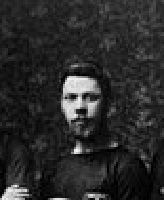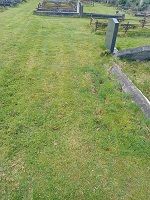Alexander "Sandy" Kennedy

Although Alexander "Sandy" Kennedy's entire footballing career was spent in Glasgow he was originally a Leven Vale man, born there in 1853, although it is not clear on what side of the bridge that connected and still connects Alexandria and Bonhill. His father, John, was a Calico Engraver, the same profession his son would also pursue. His mother was a Cowan, a surname redolent of Vale of Leven, Renton and Aston Villa history. In his childhood he mixed with equally redolent McLintocks, McPhersons and McAulays.
He was a stocky 13st; not tall, with tree-trunk thighs, not quick but able to read the game and a very good passer. They were a physique and talents that over almost a decade from 1875 to 1884 would bring him six caps without defeat, three against England, three against Wales at half-back, three for Eastern, three for Third Lanark. And he would be in the Thirds' team that lost the 1878 Scottish Cup Final, to Vale of Leven, finally retiring in 1884, but for one final sally the following year. He would then turn to officiating and be an on-field umpire at the 1888 Scotland-England match, in the season when he was also President of the SFA.
There is even a case that, had he remained in the Vale, he might have been a shoe-in at right half for Vale of Leven but, whilst ties must have remained strong, his football education remained Glaswegian. By 1871, so before football arrived outside the city, the whole family had moved to Dennistoun. He is said to have picked up the game at Glasgow Green, less than a mile from his home, Eastern being formed in 1872 but not lasting long. It dissolved by 1877 by when he had moved on to South Glasgow to be joined at the original Cathkin Park by younger brother, James, also born in the Vale.
However, having married Isabella Maxwell in 1876 and with six of what would be nine children in 1892 he took the family across the water to Belfast, never to return. Living in and around the city he continued to work as an engraver until retirement with no obvious involvement in the local game. His wife would die in 1931 but he would live on into his nineties, passing away in December 1944 in the City Hospital to be buried in the City Cemetery in a known but so far unmarked plot. Perhaps that might change?

Birth Locator:
1853 - Bonhill/Alexandria, Dunbartonshire
Residence Locations:
1861 - McIntyres Land, Bonhill, Dunbartonshire
1871 - 45, McIntosh St. Dennistoun, Glasgow
1881 - 212, Duke St. Dennistoun, Glasgow
1891 - 68, McIntosh St. Dennistoun, Glasgow
1901 - 266, Donegal Road, Belfast
1911 - 31, Magdala St. Cromac, Belfast
Grave Locator:
City Cemetery, Belfast, Glenalina Extension, Section E, Plot 98
Back to the Irish Trail
or The Leven Trail 1 - Alexandria and Bonhill
or the SFHG Home page